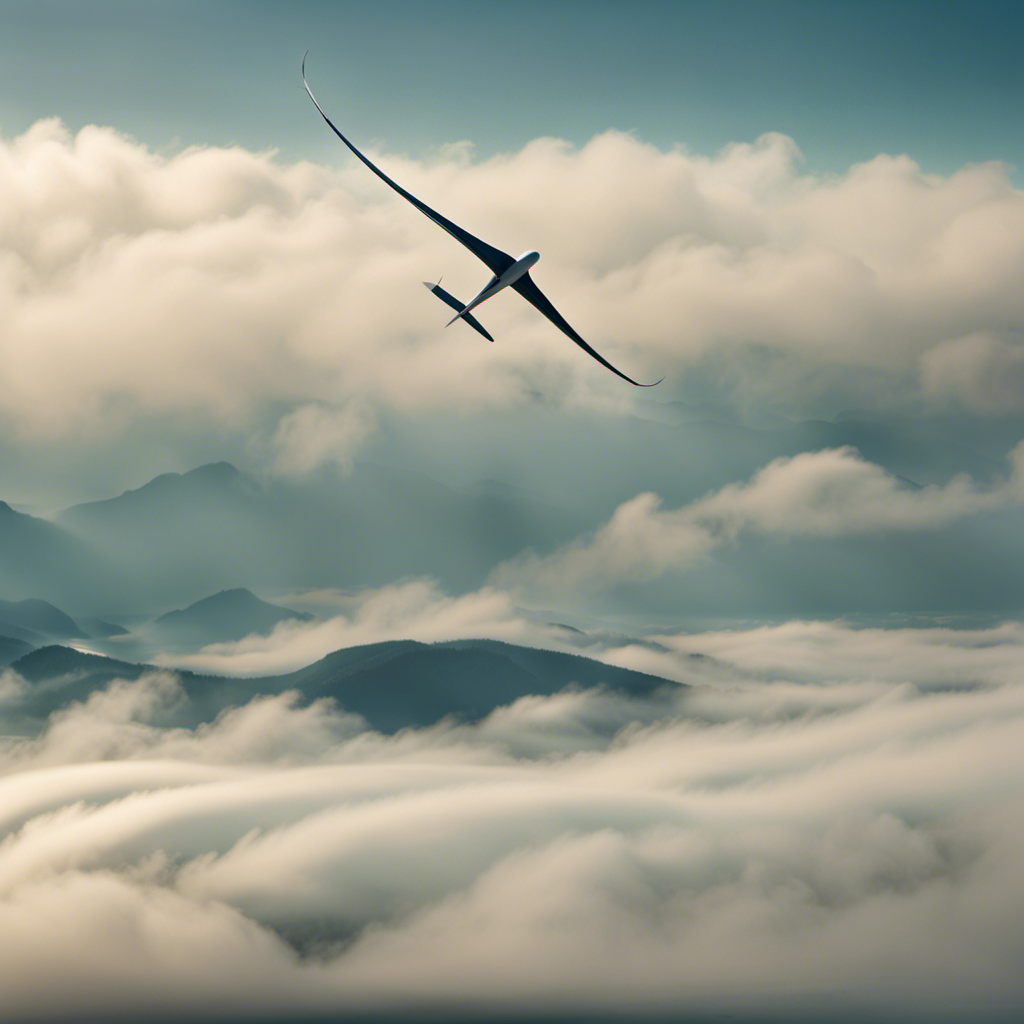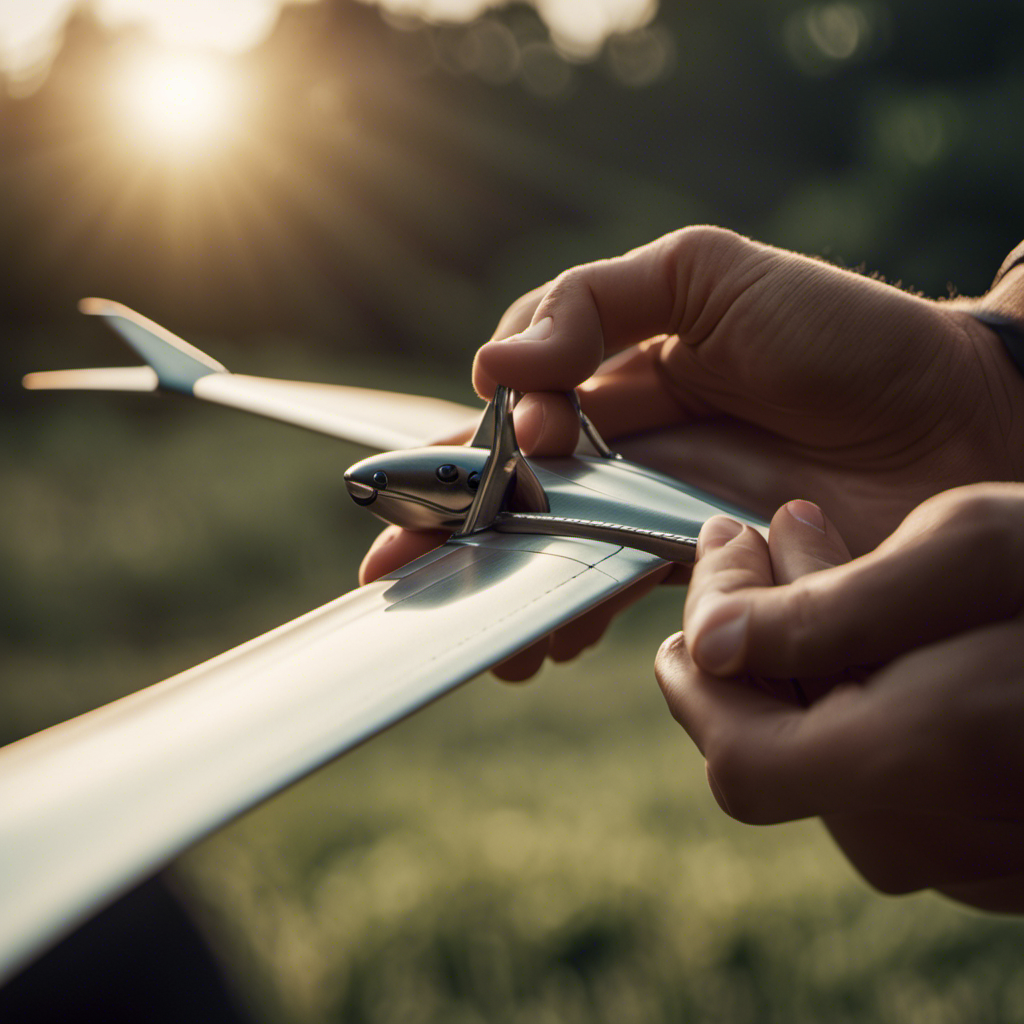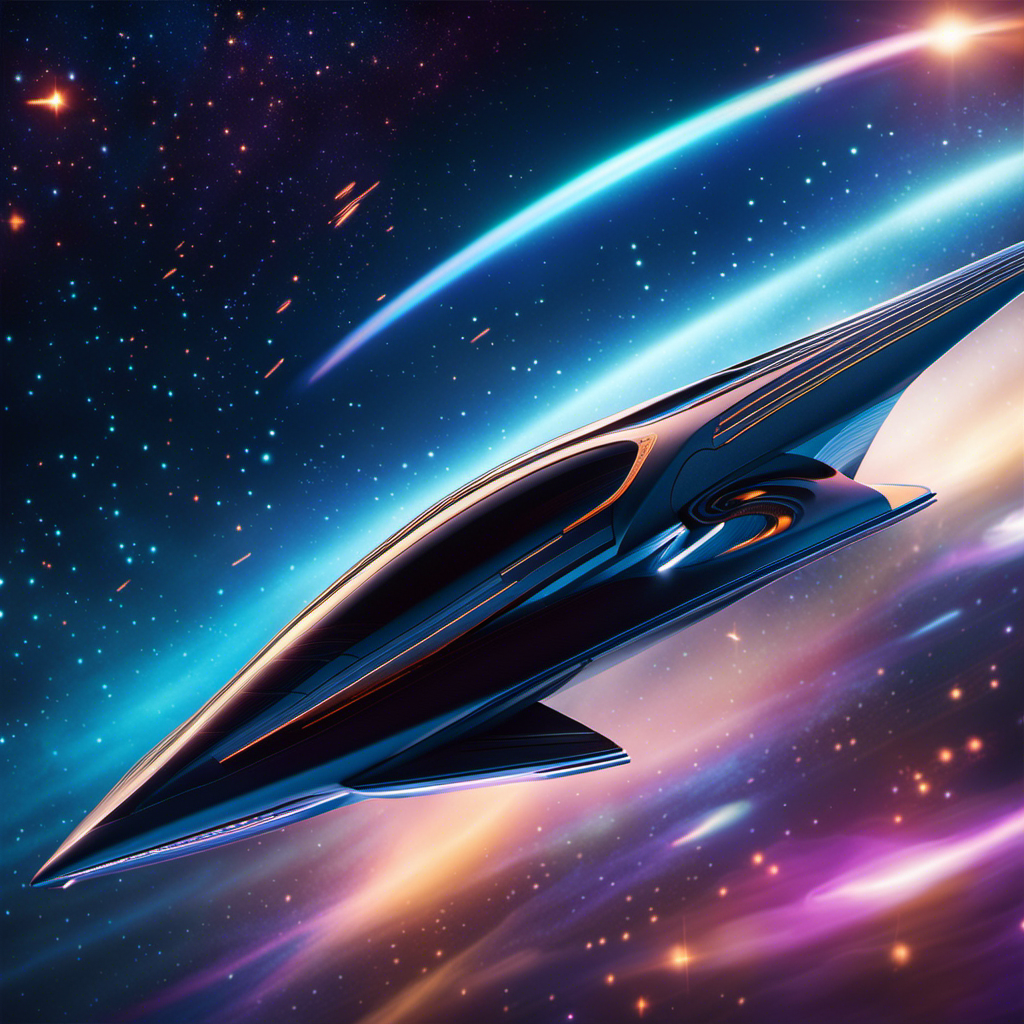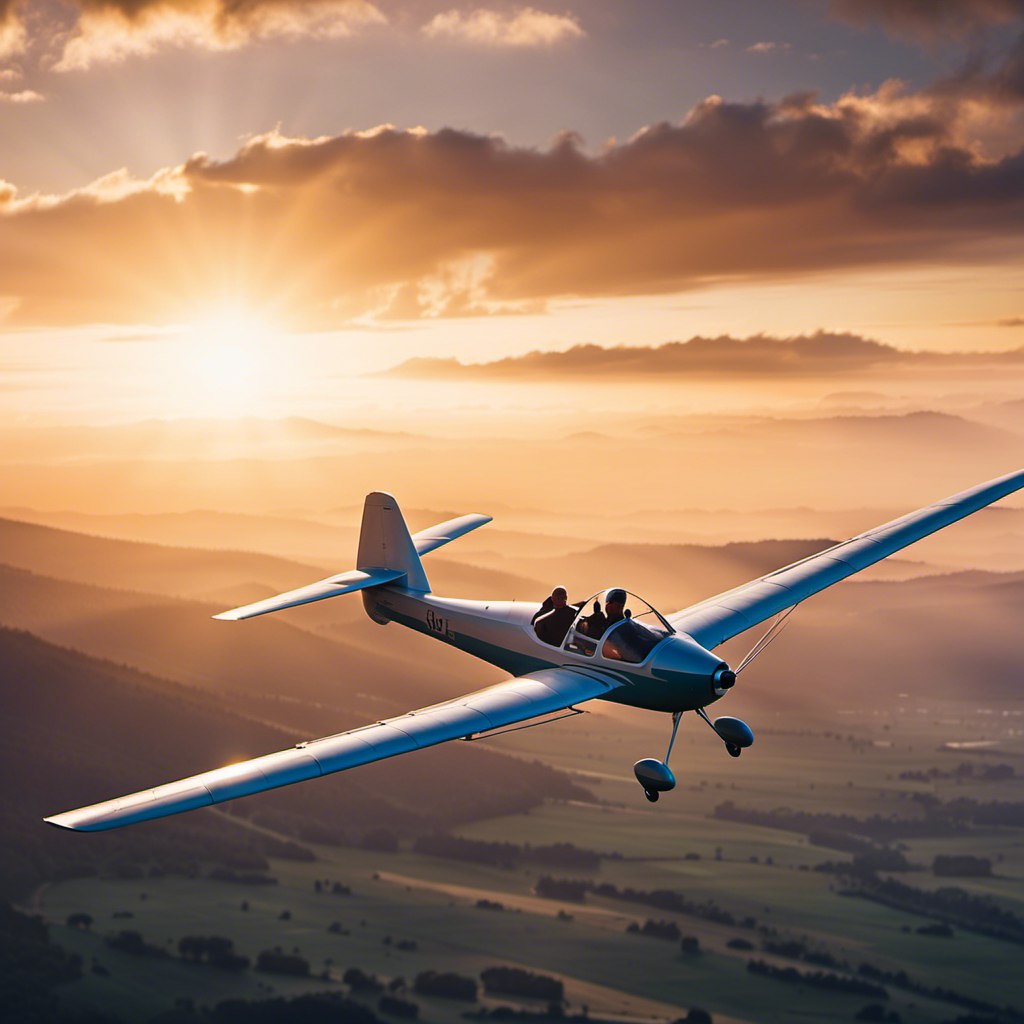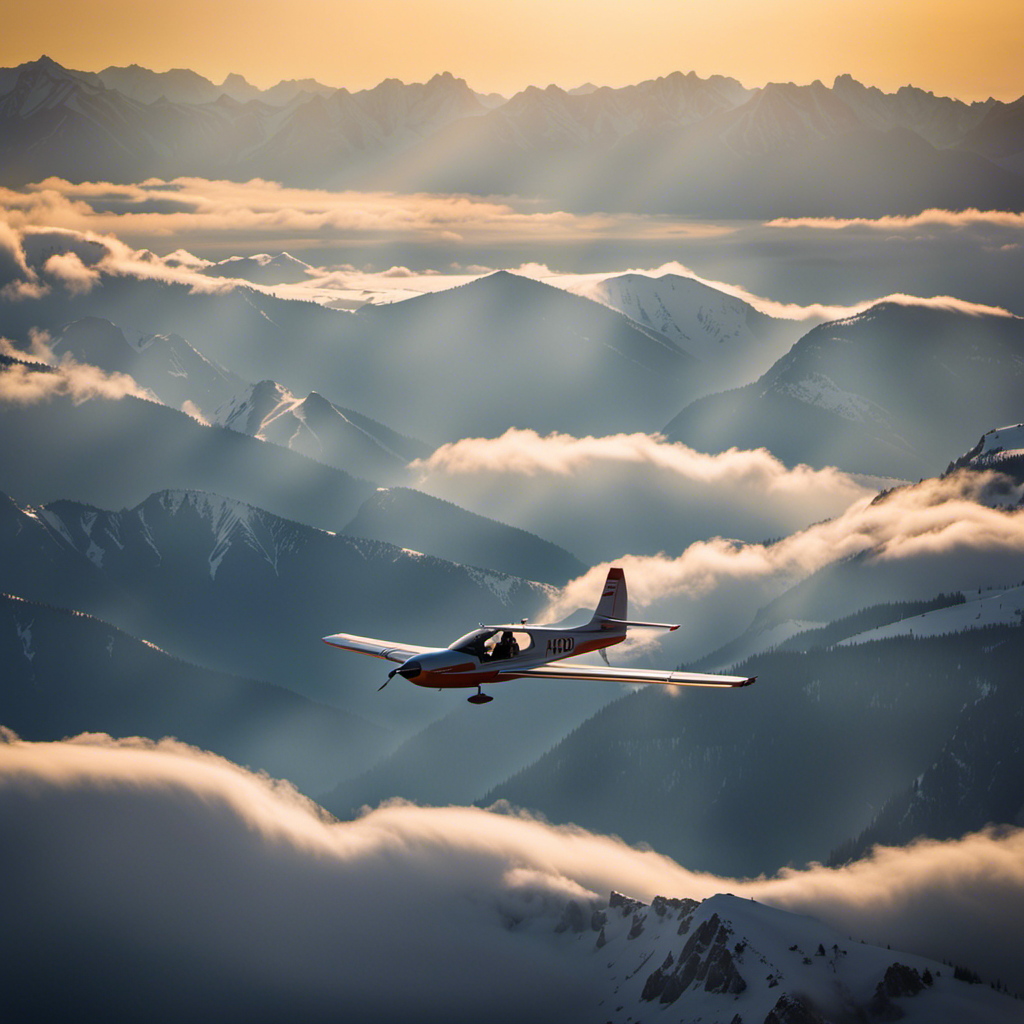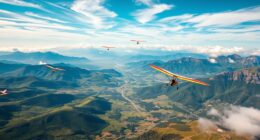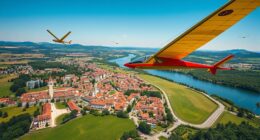It might appear that a glider, without an engine, would simply fall from the sky. But rest assured, that is not the case. In reality, gliders can stay in the air by harnessing the power of nature and utilizing their unique aerodynamic design.
In this article, I will explain the basic principles of glider flight, from understanding lift and gravity to controlling glide ratio and sink rate.
So buckle up, because we’re about to take flight into the fascinating world of glider aviation.
Key Takeaways
- Lift generated by the wings allows a glider to stay in the air.
- Drag acts against the glider’s motion and must be managed for optimal efficiency.
- Efficient use of energy through techniques like thermalling and ridge soaring can keep a glider aloft for extended periods.
- Proper decision-making, safety measures, and adherence to procedures are crucial for a safe and successful glider flight.
The Basic Principles of Glider Flight
To stay in the air, a glider relies on the basic principles of flight. Understanding aerodynamics is key to maximizing lift and keeping the glider aloft.
Lift is the force that counteracts gravity and allows the glider to rise and stay airborne. It is generated by the shape and angle of the wings, known as the airfoil. As the glider moves through the air, the airfoil shape creates a pressure difference between the upper and lower surfaces of the wings. This pressure difference generates lift, pushing the glider upwards.
Understanding Lift and Gravity
Understanding lift and gravity, a glider stays in the air by generating enough upward force to counteract the force of gravity. How does this happen? Here are three key points:
-
Lift generation: Lift is the force that opposes gravity and keeps the glider airborne. It is generated by the interaction between the wing and the air. As the glider moves forward, the shape of the wing and the angle at which it meets the oncoming air create an area of low pressure above the wing, causing the glider to rise.
-
Aerodynamic forces: The glider experiences two main aerodynamic forces – lift and drag. Lift is the upward force that keeps the glider in the air, while drag is the resistance the glider experiences as it moves through the air. To stay aloft, the glider must generate enough lift to counteract the drag.
-
Balancing forces: To maintain level flight, the glider must find a balance between the forces of lift and gravity. By adjusting the control surfaces, such as the elevator and ailerons, the pilot can control the amount of lift being generated and maintain a steady altitude.
Now, let’s explore the role of wing shape and angle of attack in further detail.
The Role of Wing Shape and Angle of Attack
Adjusting the shape of your wing and the angle at which it meets the air are key factors in generating lift and keeping your glider airborne. The design of the wing plays a crucial role in achieving optimal lift-to-drag ratio. By carefully shaping the wing, engineers can reduce drag and improve the glider’s efficiency.
The wing’s angle of attack, which is the angle between the wing’s chord line and the oncoming airflow, also affects lift and drag. A higher angle of attack increases lift but also increases drag. Finding the right balance is essential for maintaining steady flight.
As we explore the role of wing design and the impact of drag, it becomes clear that these factors are fundamental in achieving flight. Understanding these principles will lay the foundation for effectively utilizing thermals and updrafts in the subsequent section.
Utilizing Thermals and Updrafts
Make sure you take advantage of thermals and updrafts to stay airborne longer.
Thermals and updrafts are both natural phenomena that provide gliders with the necessary lift to maintain altitude and extend their flight time. However, there are some key differences between the two.
Thermals are columns of warm, rising air caused by the uneven heating of the Earth’s surface. Gliders can circle within these thermals to gain altitude and remain aloft.
Updrafts, on the other hand, are vertical currents of air that are generated by the interaction of wind with various geographical features, such as hills or cliffs. They can be less predictable than thermals but can still provide gliders with additional lift.
Understanding the characteristics of thermals and updrafts is crucial for maximizing glider efficiency and achieving longer flight durations. By utilizing these natural sources of lift, glider pilots can extend their flight time and cover greater distances.
Now, let’s discuss how controlling glide ratio and sink rate further enhances glider performance.
Controlling Glide Ratio and Sink Rate
Controlling glide ratio and sink rate is essential for maximizing glider performance and covering greater distances. To achieve this, there are several key techniques that pilots employ:
-
Controlling airspeed: By adjusting the position of the control surfaces, such as the elevator and ailerons, the pilot can control the glider’s airspeed. Increasing the airspeed can help reduce sink rate, allowing the glider to maintain altitude and cover more ground.
-
Adjusting control surfaces: The pilot can manipulate the control surfaces to change the angle of attack and lift of the glider. By slightly increasing the angle of attack, the glider can generate more lift, reducing the sink rate and extending the glide ratio.
-
Utilizing energy management techniques: Pilots can also use energy management techniques, such as flying in areas of lift or avoiding areas of sink, to control the glide ratio and sink rate. This involves reading the air currents and thermals to maintain or gain altitude.
By mastering these techniques, pilots can effectively control the glide ratio and sink rate, optimizing their glider’s performance.
This leads us to the next important aspect of gliding: the importance of weight and balance.
The Importance of Weight and Balance
To optimize your glider’s performance, it’s crucial that you understand the importance of weight and balance. Proper weight distribution is essential for maintaining stability and control during flight. The way you distribute weight affects the glider’s center of gravity, which directly impacts its maneuverability. By ensuring that the glider is properly balanced, you can achieve optimal flight characteristics.
A well-balanced glider will be more responsive to control inputs and will maintain stability in various flight conditions. It’s important to note that weight and balance should be regularly checked and adjusted if necessary, as changes in payload or equipment can affect the glider’s performance.
Now that we have covered the importance of weight and balance, let’s move on to how to launch and land a glider seamlessly.
How to Launch and Land a Glider
Once you’re ready for takeoff, remember to keep a steady hand on the controls while smoothly applying power to lift off the ground. Launching a glider requires proper techniques to ensure a safe and efficient ascent. The table below outlines some key launch techniques and landing techniques that every glider pilot should be familiar with:
| Launch Techniques | Landing Techniques |
|---|---|
| Winch launch: | Approach and touchdown: |
| – Maintain control | – Establish a stabilized |
| – Apply gradual power | approach |
| – Keep the nose level | – Reduce speed and descend |
| Aerotow launch: | smoothly |
| – Maintain position | – Flare just before |
| – Communicate with | touchdown |
| the towplane pilot | – Touch down gently and |
| for proper timing | roll to a stop |
| Self-launch: | |
| – Follow proper startup | |
| and shutdown procedures | |
| – Control the climb rate | |
| – Monitor engine |
Mastering these techniques is crucial for a successful glider launch and landing. However, the role of pilot skill and experience goes beyond these technical steps. It involves decision-making, situational awareness, and adaptability in various conditions.
The Role of Pilot Skill and Experience
Transition: Now that we understand the techniques of launching and landing a glider, let’s delve into the crucial role of pilot skill and experience in ensuring a smooth and controlled flight.
Current Subtopic: The Role of Pilot Skill and Experience
As a glider pilot, one must possess a strong foundation of knowledge and proficiency in aerodynamics. This expertise allows pilots to understand the principles behind how a glider stays in the air and make informed decisions during flight. Here are three key aspects of pilot training and aerodynamics proficiency that contribute to a successful gliding experience:
-
Understanding Lift and Drag: Pilots must comprehend the forces at play, such as lift generated by the wings and the drag acting against the glider’s motion, to maintain optimal speed and efficiency.
-
Managing Energy: Skilled pilots know how to efficiently use and conserve the glider’s energy, utilizing techniques like thermalling and ridge soaring to stay aloft.
-
Decision-making: Experienced pilots possess the ability to analyze weather conditions, plan flight routes, and adapt to changing circumstances, ensuring safety and maximizing performance.
Transition: With a solid foundation in pilot skill and aerodynamics proficiency, we can now explore the essential safety measures and precautions to ensure a secure gliding experience.
Safety Measures and Precautions
Pilots must prioritize safety by implementing various measures and precautions to ensure a secure gliding experience. Safety measures include thorough pre-flight inspections, adherence to weight and balance limits, and proper use of safety equipment such as helmets and harnesses.
Additionally, pilots must be knowledgeable and prepared to handle emergency situations by following established emergency procedures. These procedures may include actions like deploying the emergency parachute, initiating a controlled landing in case of a loss of lift, or communicating with air traffic control in the event of a radio failure.
By consistently practicing these safety measures and being prepared for emergencies, pilots can mitigate risks and ensure the overall safety of glider flights.
Transition: With safety as our top priority, we can now delve into the thrilling and beautiful aspects of glider flight.
The Thrill and Beauty of Glider Flight
After covering the necessary safety measures and precautions, it is time to delve into the thrilling and breathtaking aspects of glider flight. As a pilot myself, I have had the privilege of participating in glider competitions and experiencing the exhilarating world of glider aerobatics.
Glider competitions are events where pilots showcase their skills in navigation, precision flying, and speed. These competitions push pilots to their limits, testing their abilities to read weather conditions, plan strategic routes, and make split-second decisions. It is a true display of expertise and finesse.
Glider aerobatics, on the other hand, takes flight to a whole new level. It involves performing intricate maneuvers such as loops, rolls, spins, and stalls. The grace and precision required to execute these maneuvers is awe-inspiring. It is an exhilarating experience that combines the beauty of flight with the thrill of pushing the boundaries of what a glider can do.
Frequently Asked Questions
What is the average cost to purchase a glider?
The average cost to purchase a glider varies depending on the model and features. There are various purchasing options available, such as buying new or used, or even leasing. It is important to research and compare prices before making a decision.
How long does it take to learn how to fly a glider?
Learning to fly a glider has a steep learning curve, but with proper training, it can take around 20-30 hours of flight time. The duration may vary based on individual progress and the training program.
Are there any age restrictions for flying a glider?
There are age restrictions for flying a glider as per safety regulations. These restrictions ensure that individuals are physically and mentally capable of operating the glider safely.
Can gliders fly in bad weather conditions?
In bad weather conditions, gliders can still fly using specific flying techniques. However, it’s important to note that wind speed has a significant impact on glider flight, which can make it more challenging and potentially dangerous.
How far can a glider travel without any power source?
The longest glider flight on record is 2,463.8 kilometers. Gliders can travel long distances without a power source by utilizing thermals, ridge lifts, and wave lifts to stay aloft.
Conclusion
In conclusion, glider flight is a remarkable feat of engineering and skill. By harnessing the principles of lift and gravity, gliders are able to stay aloft for extended periods of time.
The shape and angle of attack of the wings play a crucial role in maintaining stability and control.
Pilots must also skillfully utilize thermals and updrafts to maximize their glide ratio and minimize their sink rate.
With proper training and experience, the thrill and beauty of glider flight can be experienced firsthand.
So, spread your wings and soar like an eagle, for the sky is truly the limit.
With a heart that soars as high as the skies, Aria, affectionately known as “Skylark,” is the driving force behind Soaring Skyways. Her journey into the gliding world began as a young dreamer gazing up at the soaring birds, yearning to experience the weightlessness and freedom they embodied. With years of experience both in the cockpit and behind the scenes, Aria’s commitment to the gliding community is unwavering.
